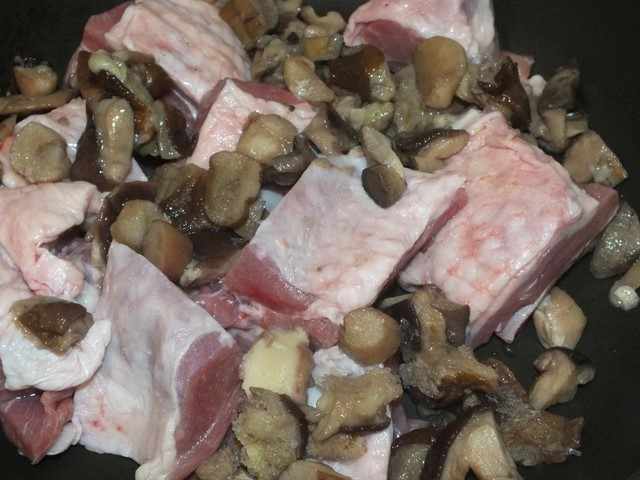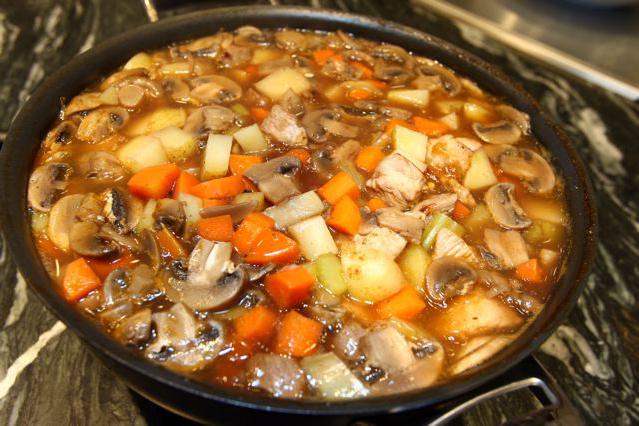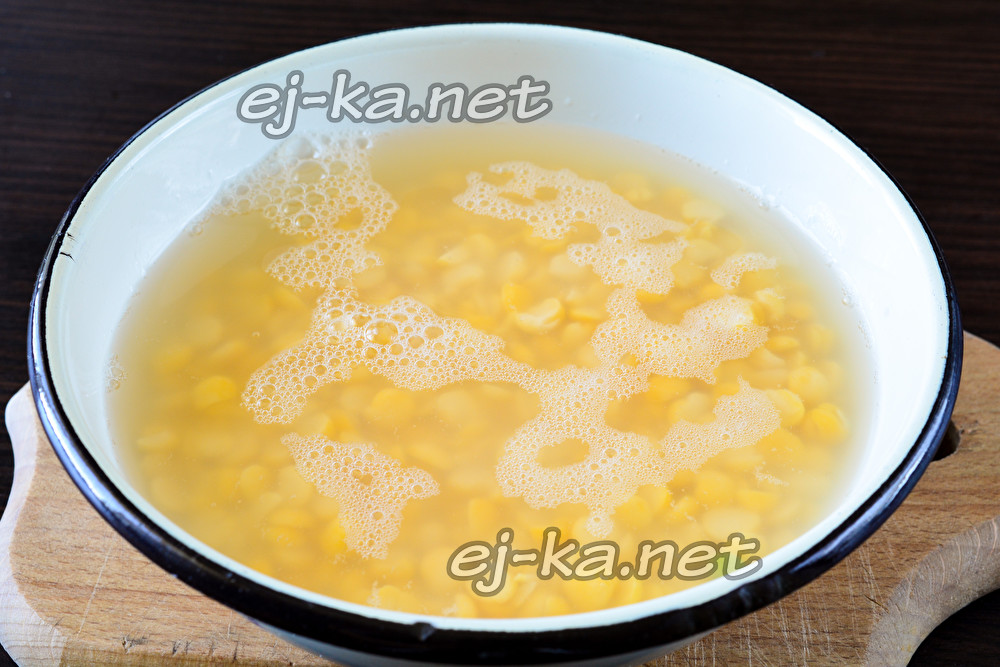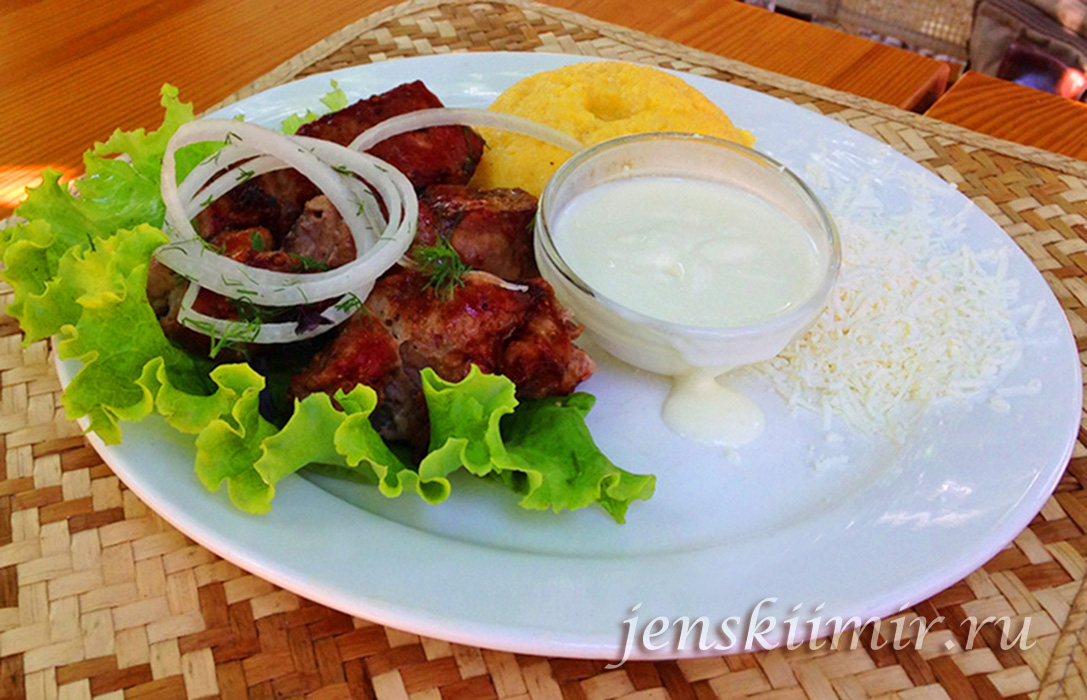Khinkali recipe step by step with a photo and from a real Georgian
Khinkali recipe with photo
A wonderful Georgian dish khinkali vaguely resembles dumplings, but much tastier. This is a hearty dough dish stuffed with meat and a fragrant broth in the middle. Khinkali is difficult and capricious in preparation, but if you make every effort, you will get a divinely delicious dish as a result. I offer my own recipe for making khinkali.
I knead the dough for khinkali in two stages. First, I kneaded the dough of the same consistency as for pancakes. I poured 4 cups of sifted premium flour (a glass of 200 ml) into a wide bowl. Flour must be sifted.
Then I made a depression in the flour and poured in 2 glasses of ice water, 4 tablespoons of sunflower oil.
Pour ice water and sunflower oil into the flour.
I added salt and, after kneading the dough, left it for 30 minutes. After this time, I added three and a half glasses of flour and kneaded the dough for 15 minutes. The dough should be firm and elastic enough. At the end of kneading, the dough should lie down for another 15 minutes.
Minced meat can be made from pork or lamb. I took pork.
I twisted the meat in a meat grinder (on a coarse mesh). Finely chopped onion mixed with salt, added to the minced pork.
From the spices to the minced meat, I added black pepper and cilantro seasoning. I have a very aromatic seasoning, since I brought it from Georgia. It would be nice to use fresh, chopped cilantro, but I cooked khinkali spontaneously, and I didn't have fresh herbs at home, so I had to use seasoning. In the minced meat, stirring constantly, you need to add ice water. I kneaded it for about 15 minutes so that the minced meat was homogeneous and elastic, so that no water remained in the bowl, and then I put the bowl with the minced meat in the refrigerator for half an hour.
When everything is prepared: both minced meat and dough, we proceed to the formation of khinkali. The dough must be divided into parts. While I roll out one part of the dough on a table, sprinkled with flour, into a thin layer, the rest of the parts lie covered with a towel. The dough turned out to be elastic, so it can be rolled into a thin layer.
Then I cut out circles from dough, blanks for khinkali. When I made khinkali for the first time, I used a saucer to cut circles out of dough. I didn't really like it, because the khinkali turned out to be too large. Then my son suggested that I use a defective DVD disc for cutting out circles. I tried to cut a circle around the disk, and the khinkali turned out to be the size I needed.
Then I put minced meat in the middle of the circle, lift the edges of the cake and connect them in a circle with folds, an accordion, collecting the dough in a bag.
During the assembly of khinkali, you need to hold the already formed folds of dough with the fingers of one hand, and form these folds with the other hand.
The result is a pouch, the folds of which I tightly squeeze from above into a knot.
Before joining the folds into a knot, I pour the juice from the minced meat into the hole with a teaspoon.
I connect the folds into a knot.
I put the formed khinkali on the table, sprinkled with flour.
It is good to cook khinkali with an assistant. While one rolls out the dough and cuts out circles, the second forms khinkali. Khinkali should be cooked in portions, because if you stick a lot of khinkali at once, and then cook them, then while they are on the table, they will lose their shape and, in addition, the dough may get wet and tear.
I put a large pot of salted water on the fire in advance, and when the water boils, you can put the first batch of khinkali into it.
I lift each khinkali separately by the bundle, hold it a little so that the bag sags, and carefully throw it into the boiling water. Khinkali can stick to the bottom of the pot. Therefore, as soon as they sink to the bottom, you need to carefully pry them off with a wooden spoon or turn the pan so that the khinkali will come off. As soon as the khinkali pop up, I cook them for 10 minutes.
I quickly take out the finished khinkali with a slotted spoon and put it on a wide dish.
Since these are Georgian khinkali, they must be sprinkled with black pepper and be sure to eat with delicious!
They are eaten hot. At the same time, they take khinkali with their hands by the bundle, carefully biting them from the side, so as not to spill the juice, and after drinking the juice, they eat the khinkali. You don't have to eat the tail for which the khinkali was held.
I hope you enjoy the khinkali prepared according to this recipe - a homemade khinkali recipe with a photo. Bon Appetit!
Georgian khinkali recipe
(Everything will be delicious khinkali)
Question: What should be the ratio of flour and water in the dough for khinkali so that they do not burst?
Answer: 250 ml of water for 500 grams of flour
Question: How thick should the rolled dough be?
Answer: 2 millimeters
Question: What should be the ratio of minced meat and dough in order for khinkali to cook evenly?
Answer: for 100 grams of dough there should be 100 grams of minced meat
Ingredients for minced meat:
- beef - 500 grams
- pork - 500 grams
- onions - 300 grams
- salt - 1/2 teaspoon salt
- pepper - 1/2 teaspoon
- thyme - a pinch
- zira - a pinch
- garlic - 2-3 cloves
- warm water - 200 ml
Ingredients for the dough:
- flour - 500 grams
- water (ice) - 250 mol of water
- salt - 1 teaspoon
- vegetable oil - 30 ml
The meat needs to be washed and dried a little. We clean the meat from the veins.
So that the minced meat in khinkali does not look like meatballs, the meat must be chopped very finely. To make the meat much easier to chop with a knife, the meat must first be put in the freezer for 15-20 minutes.
Pour flour into the center and make a hole in the middle. Add ice-cold salted water, vegetable oil and knead. Knead the dough on a board, from 15 to 30 minutes! After the dough, we give the shape of a ball, wrap it in plastic wrap and send it to the refrigerator for 15 minutes.
When the meat is chopped, add chopped onion, salt and spices to it. Leave the minced meat for 15-20 minutes to marinate the meat. The consistency of minced meat should be like thick sour cream (for this, warm water is added).
Khinkali are steamed over boiling water for 7-10 minutes. After removing them from the pan, sprinkle them with cold water.
There are all 3 fillings in the form:
- with meat
- with vegetables
- sweet
All 3 ways of cooking khinkali:
- for a couple;
- in boiling water in a whirlpool;
- in boiling water with a twist.
Features of Georgian cuisine
Georgian cuisine is inherently distinctive and peculiar, very popular in different countries of the world. And some dishes have become international (for example)
Despite the fact that Georgia is, in fact, a small country, differences in the agricultural sectors of different regions of the country played a role in the formation of the cuisine. In one part of Eastern Georgia (Kakheti, Kartli), bread baked in large cylindrical jugs is common. In addition, this part of the country eats a lot of fat. In the second part of Eastern Georgia, dumplings stuffed with lamb, very heavily peppered and seasoned with spices, became widespread. They are called khinkali, but they differ significantly from dumplings in that khinkali are eaten without broth.
In Western Georgia, the mch adi (cornbread) became very popular. In Abkhazia and Mingrelia, instead of bread, they use thick corn porridge. Spicy food is common on the coast, with preference given to poultry.
In addition to the differences in cuisine, there are many national dishes on the territory of Georgia. These include meat on a skewer, which we call kebab. Georgians call him mivadi. In addition, both Eastern and Western Georgia are famous for their spicy sauce consisting of nuts and spices - satsivi. This sauce is used in the preparation of poultry. The most common poultry dish is chicken or turkey broth, seasoned with flour, eggs and onions shaken in vinegar - chikhirtma, as well as chakhokhbili, to which a large amount of onion is added.
If we talk about Georgian dishes, one should also remember about lobio (beans), which can be prepared according to many recipes. Cheese pies are widespread throughout Georgia -. Do not forget that it is an irreplaceable part of the national cuisine. Western Georgia prefers suluguni cheese and similar Imeretian cheese (puff cheese in the form of a flat cake). In the East, on the contrary, they like spicy cheeses. These include Tushinsky, Kobi. A wide variety of different dishes can be prepared from cheeses.
Beef leg broth, richly seasoned with garlic, is also very popular. It is called hashi. According to Georgian tradition, this broth should be eaten in the morning after a hearty feast with delicious Georgian wine. Well, just for lunch - of course.









